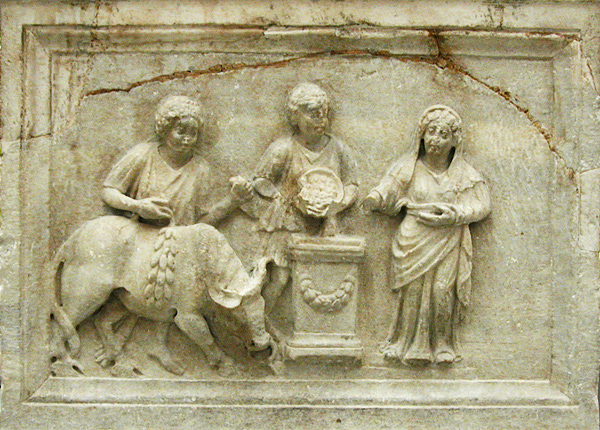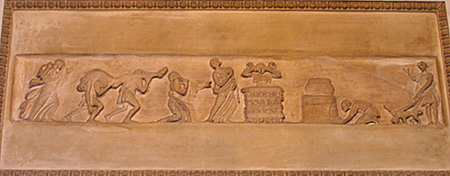 Sacrifice, relief from Altar, Nemi, 200 CE |
|
|
Apart from state religious enactments, Roman women took part in private religious observances. While texts for some of these practices do not survive (e.g. prayers women uttered to Lucina, goddess of childbirth), we have evidence for the participation of women in the important family worship of the Lar familiaris and of the Lares compitales, in funeral rites and religious ceremonies relating to the dead (Parentalia, Karistia), and in the Terminalia, a festival honoring the god that protected the borders of the family's property. This page contains texts which describe their roles in these events. |
Lar Familiaris: Lares were divinities associated with places. The Lar familiaris protected all members of the household, free and slave. He was worshipped in a shrine (Lararium) in any dwelling of the household, whether villa in the countryside, domus in the city, or apartment in an insula.
 |
|
|
In Women's Religious Activity in the Roman Republic, Celia Schultz points out that as the vilica took over the duties of the absent materfamilias, Cato's discussion of the religious duties of the vilica (See The Worlds of Roman Women, p 130-131, for Cato's full text of the duties of the vilica) gives us insight into the religious duties of the materfamilias.
| Focum purum circumversum cotidie, priusquam cubitum eat, habeat. Kal(endis), Idibus, Nonis, |
| festus dies cum erit, coronam in focum indat, per eosdemque dies lari familiari pro copia supplicet. |
Horace describes a rustic farmwife, Phidyle, sacrificing to her Lar familiaris (the meter is Alcaic).
| Caelo supinas si tuleris manus |
| nascente luna, rustica Phidyle, |
|
si ture placaris et horna |
|
fruge Lares avidaque porca |
As taking out food stored in the house involved contact with the Penates, and offering such food to the Lares was a religious rite, it was important for anyone involved in these actions to be ritually pure. Religious purity particularly required that one had been chaste or purified from sexual activity, as Columella explains in this excerpt:
| His autem omnibus [scriptoribus] placuit eum, qui rerum harum officium susceperit, |
| castum esse continentemque oportere, quoniam totum in eo sit, |
| ne contrectentur pocula vel cibi nisi aut impubi aut certe abstinentissimo rebus veneriis: |
| quibus si fuerit operatus vel vir vel femina, debere eos flumine aut perenni aqua, |
| priusquam penora contingant, ablui. |
This commentary (actually the work of several scholars from c. 5th century CE and not the 2nd century CE Helenius Acron) notes that when a Roman boy assumed his adult toga pura, he dedicated his toga praetexta and bulla to the Lar familiaris in thanksgiving, while girls dedicated their childhood possessions upon their marriage.
| Solebant pueri, postquam pueritiam excedebant, dis Laribus bullas suas consecrare, |
| similiter et puellas pupas |
Varro lists the items that girls could dedicate to the Lar upon their marriage:
| Suspendit Laribus manias, mollis pilas, reticula, ac strophia. |
Before travelling a family member informed the Lar familiaris of the planned journey and asked for his protection and greeted the Lar upon returning or gave thanks when a family member, presumed lost on a journey, was happily restored. This custom held true when a new member was added to the household. For example, upon arriving at her new home a bride notified both the Lar familiaris and the Lares compitales (see below) of her husband that she was joining his household.
| Nubentes veteri lege Romana asses III, ad maritum venientes, |
| solebant pervehere, atque unum, quem in manu tenerent, tamquam emendi causa, marito dare; |
| alium, quem in pede haberent, in foco Larium Familiarium ponere; |
| tertium, quem in sacciperio condidissent, compito vicinali solere resonare. |
On the day after her marriage the bride began upon her duties as a wife, which included performing religious rites of the family:
| Nam quia primus nuptiarum dies verecundiae datur |
| postridie autem nuptam in domo viri dominium incipere oportet adipisci et rem facere divinam. |
Lar Compitalis: The Lares compitales were guardians of the compitium, the cross-roads in country or city. They were honored at the festival of the Compitalia, for which the date varied, but was always celebrated in winter.
Women participated in this celebration, as Cicero's invitation shows:
| Tu pridie Compitalia memento... et Pomponiam Terentia rogat; matrem adiungemus. |
Compitalia: On the Compitalia each household met at the crossroads by its house or estate to sacrifice honey-cakes to the Lares and to hang objects that represented each person, free or slave, in the household.
This passage from Paulus explains that the Lares compitales were in some way connected with the dead, and the family hoped that the objects they hung would propitiate the Lares so that death would be averted from the family in the ensuing year. As women were the wool-workers (lanaficae) in a Roman family, spinning and weaving the clothing for the household, it is likely that they were responsible for making the balls of wool and woolen effigies for the Lares.
| Pilae et effigies viriles et muliebres ex lana Compitalibus suspendebantur in compitis, |
| quod hunc diem festum esse deorum inferorum, quos vocant Lares, putarent, |
| quibus tot pillae, quot capita servorum, tot effigies, quot essent liberi, |
| ponebantur ut vivis parcerent et essent his pilis et simulacris contenti. |
 |
|
|
Funerary Rites: Women also participated in the funerals of family members. In poorer households they were most likely the ones who washed the body, dressed it, and laid it out prior to the funeral procession. Professional women mourners (praeficae) might be hired, but women of the family also joined the formal mourning. Anyone that came into contact with the dead was "polluted" by death and needed to be "cleansed" of that pollution before resuming their normal life and contact with others.
Paulus explains how this cleansing was done and the symbolism behind the two elements used:
| Aqua et igni tam interdici solet damnatis, quam accipiunt nuptae, |
| videlicet quia hae duae res humanam vitam maxime continent. |
| Itaque funus prosecuti redeuntes ignem supergradiebantur aqua aspersi; |
| quod purgationis genus vocabant suffitionem. |
As in many cultures past and present, Roman women participated in a formal mourning period after the funeral. The length of formal mourning changed over time and was also affected by the age and relationship of the deceased to the grieving women. Paulus lists the lengths of mourning periods in the middle and late Republic:
| Parentes et filii maiores sex annis anno lugeri possunt, minores mense: |
| maritus decem mensibus et cognati proximioris gradus octo. |
| Qui contra fecerit, infamium numero habetur. |
By the late first century BCE, according to Seneca, only women were expected to engage in formal mourning:
| Annum feminis ad lugendum constituere maiores, |
| non ut tam diu lugerent, sed ne diutius: |
| viris nullum legitimum tempus est, quia nullum honestum. |
In the introduction to the month of March in his poem Fasti, Ovid offers some explanations why the old Roman year lasted originally only ten months; one of his explanations concerns how long a widow (vidua) was expected to mourn her husband. The meter is elegiac couplet.
| adsuetos igitur numeros servavit in anno; |
|
hoc luget spatio femina maesta virum. |
 |
|
|
Parentalia: Along with other family members, women participated in the Parentalia (February 13-21), the festival of the family dead,
Ovid describes the rites of the festival; the meter is elegiac couplet.
| lines 533-535: |
| Est honor et tumulis, animas placare paternas, |
|
parvaque in exstructas munera ferre pyras. |
| parva petunt manes. |
| lines 537-539: |
| tegula porrectis satis est velata coronis |
|
et sparsae fruges parcaque mica salis, |
| inque mero mollita Ceres violaeque solutae: |
| line 542: |
|
adde preces positis et sua verba focis. |
Karistia: The day after the Parentalia, on which they connected themselves with their dearly departed, the Romans celebrated the Karistia, on which they renewed their connections with living relatives. Women were clearly present on this day, which focused on a sacrifice to the Lar familiaris to ask him to preserve family members from death.
Ovid describes the rites of the festival on February 22; the meter is elegiac couplet.
| lines 617-626: |
| Proxima cognati dixere Karistia kari, |
|
et venit ad socios turba propinqua deos. |
| scilicet a tumulis et qui periere propinquis |
|
protinus ad vivos ora referre iuvat, |
| postque tot amissos quicquid de sanguine restat |
|
aspicere et generis dinumerare gradus. |
| innocui veniant: procul hinc, procul impius esto |
|
frater et in partus mater acerba suos, |
| cui pater est vivax, qui matris digerit annos, |
|
quae premit invisam socrus iniqua nurum. |
| lines 631-634: |
| dis generis date tura boni: Concordia fertur |
|
illa praecipue mitis adesse die; |
| et libate dapes, ut, grati pignus honoris, |
|
nutriat incinctos missa patella Lares. |
Terminalia: Another family festival was the Terminalia, held on February 23 in honor of the god Terminus, who presided over the boundaries of estates. His statue was aniconic, in the form of a boundary stone or post inserted on the boundary of the estates. The family of each estate adorned his "statue" with garlands and erected an altar on which they offered grain, honeycombs, and wine, and sacrificed a lamb or piglet. The materfamilias, or, in her absence, the vilica of the estate, brought the flame to light the sacrificial fire.
| Ara fit: huc ignem curto fert rustica testo |
|
Sumptum de tepidis ipsa colona focis. |
Click on the underlined words for translation aids and commentary, which will appear in a small window.